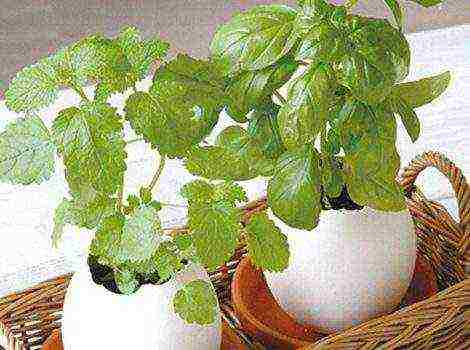Content
- 1 Where can I buy seeds?
- 2 What kind of soil to use?
- 3 Which container to use?
- 4 What are the best herbs for growing on a windowsill?
- 5 Growing herbs at home
- 6 Herbs: what's with what?
- 7 Herbal oil at home
- 8 Soil preparation and containers
- 9 All types of greens, how to grow
- 10 Borago and marjoram
- 11 Lettuce and mustard
- 12 Green onions: growing in boxes (video)
- 13 Parsley, dill, basil and onion
- 14 How to grow dill at home in winter (video)
- 15 Gallery: greens at home (15 photos)
- 16 Rosemary
- 17 Thyme
- 18 Lavender
- 19 Basil
- 20 Parsley
- 21 Sage
- 22 Coriander
- 23 Chives
- 24 Dill
- 25 Mint
- 26 How to start growing your garden
Greetings, friends!
How beautiful a small vegetable garden with spicy crops looks on the windowsill! It is simply impossible to enjoy the aroma to its fullest in the cold winter time, when you so want summer warmth. The main thing is that, if desired, greens can be used for cooking or fresh consumption, taking the necessary vitamins. How to grow herbs in your apartment? Spicy herbs on the windowsill growing at home where to start? From seeds, of course.
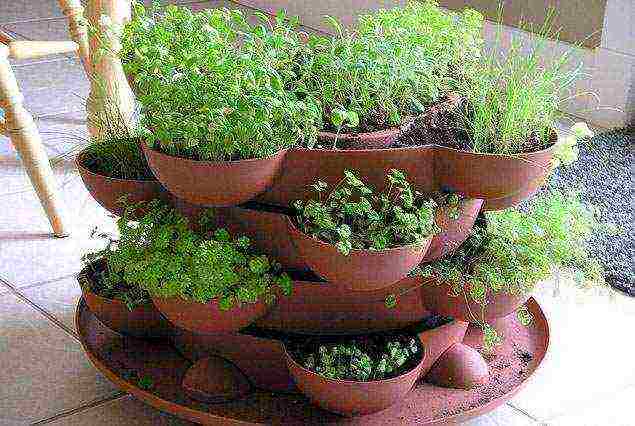
Where can I buy seeds?
Purchase of seeds can be done at a nursery or in a specialty store. Here you will find a variety of herbs and vegetables. In addition, such shops sell ready-made herbal seedlings, which are sold in pots. If you have your own planting material, then you can use it. When buying seeds, it is better to give preference to early varieties, this will make it possible to get green products earlier.
Also, seeds can be ordered with home delivery, for example, here.
What kind of soil to use?
Most herbs prefer a loose, nutritious soil. You can buy ready-made soil, which is sold in every flower shop. For planting, it is better not to use garden or garden soil, since it can contain pathogens, in addition, it is heavy and acidic. But if you still have to use garden soil, then it must be sterilized in the oven or held over steam.
The primer can be ordered with delivery here.
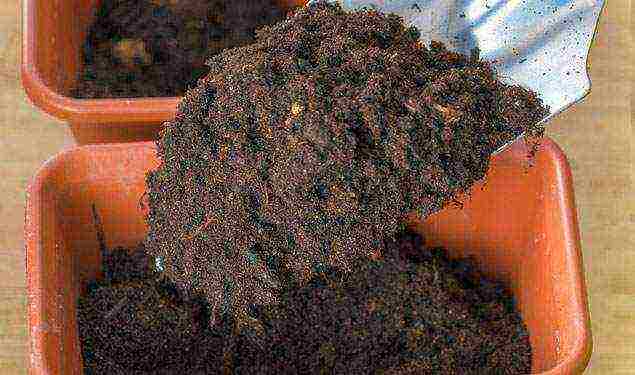
There are some plants that do not have to be grown in soil. For example, watercress, mustard greens, or onions. To sow the first two options, you will need a damp cloth, which must be spread in a container. You can use a paper towel or cotton wool instead of a napkin. The main thing with such a cultivation will be constant moistening of the base.
It will be easy to grow onions on a feather. The simplest method is to place the onion in water and put it into the light. In order not to form an unpleasant odor, it is necessary to change the water base more often, then the decay process does not form.
Which container to use?
It is possible to use absolutely any object that has a bottom and walls. In order to grow onions on a feather, you can use plastic jars with lids, in which holes are made to accommodate a third of the onion. The jar is filled with water to the level of onion roots. After that, it remains to add some water. Gradually, the bulb decreases in size, as it gives its strength to the green shoots. You can add organic fertilizers to the water to continue forcing the feathers.
Of course, special pots for herbs are also sold, bright and colorful. If you want, you can buy them too.
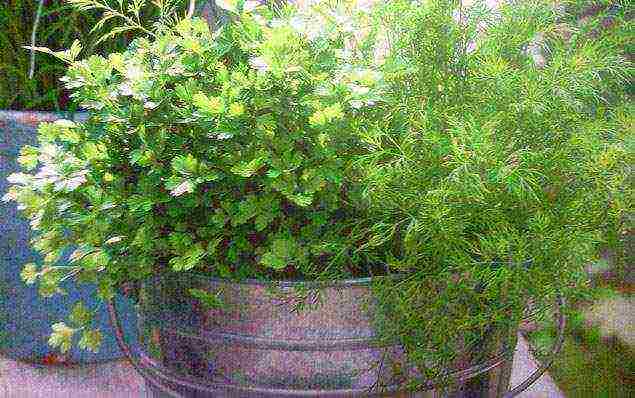
What are the best herbs for growing on a windowsill?
People grow a lot at home, but there are herbs that almost everyone prefers. They are used in cooking, and planted on the windowsill, since spicy herbs are easy to care for.
- Onion. How exactly to grow it has been described. We can only say that you should select the same size bulbs for planting. You must first remove the top layer, in addition, some cut off the top for the rapid appearance of feathers.
- Watercress. It is unpretentious in leaving. It is grown both in soil and in water, you can put the pot in the light or in the shade. It perfectly tolerates the lack of light. Harvesting is done when the sprouts reach a height of 5 cm. Such greens are eaten in the form of salads, sauces. It is also added to soups and sandwiches. This greenery contains various substances useful for the body.
- Mustard leaf. Not inferior in ease of care to watercress. You can grow these species in one container. It is consumed both raw and processed.
- Dill. Widespread product. An unpretentious plant, but it is better to acquire early varieties, from which you can harvest after 25 days. If you buy a late version, then you will have to wait for the greens for a month and a half.
- Leaf salad. Such a culture requires better conditions. She "likes" to be in bright light and warm. Although the kitchen is ideal for such a plant, you will have to use artificial lighting.
- Basil. Loves warm places, will decorate any kitchen thanks to its green and purple leaves. If you put several varieties in one container, you get an interesting color composition. The optimum temperature for growing is considered to be 25-28 degrees.
- Coriander. Unpretentious. It grows in almost any light. The only thing that does not stand up is when the water stagnates or the soil dries up. Therefore, it is necessary to water the spice in a timely manner and in moderation.
- Lemon thyme. Smells delicious, fills the room with aroma. If you plant such a perennial, which, moreover, does not differ in special requirements, then the delicate scent of lemon will delight you for many years.
- Rosemary. This plant is essential for those who prefer Mediterranean cuisine. With its carved leaves and a wonderful spicy scent, this herb will delight the eye and give delight in aromas. It is possible to purchase a small plant or grow seeds, although it will take a long time and will take a lot of effort.
- Parsley. This herb can be grown by seed or by forcing from the roots. The second way will be able to get the harvest faster. Growing will require a warm, bright room and even watering. Parsley does not really like to live on the windowsill, but it is in demand among gardeners.
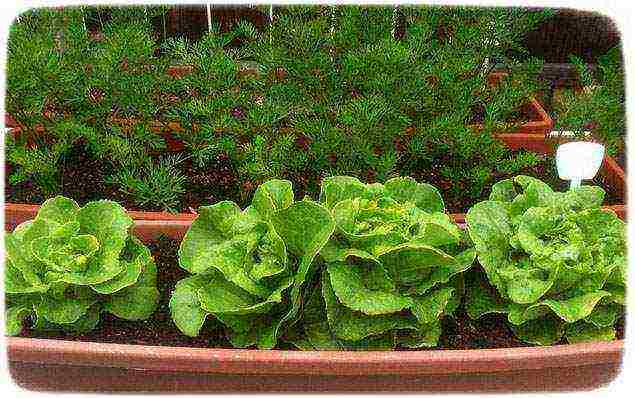
Some tips for growing
- Many herbs need proper lighting. Additional lighting is not needed only onions and watercress.
- You can use a hydrogel to maintain optimal moisture.
- The presence of a drainage layer is imperative so that there is no decay of the roots.
- Purchase only seeds from a reputable manufacturer.
- To prevent the roots of the windowsill from freezing, use wooden or plastic supports. If protection from dry air coming from the battery is required, you can put a container filled with water next to the pots.
- When using organic fertilizers, it is important to observe the measure, an excess of the drug is unacceptable.
- You can plant plants in anything. Show your imagination, use the materials at hand.
With a little hard work and patience, you will get a huge assortment of greens on the windowsill, rich in vitamins that our body needs so much.
Did you like the article? Share with your friends
Please rate the usefulness of the material
Rating: 5 out of 5 (4 votes)
Each dish has its own spicy herb, leaves and stems that add flavor. All these greens are in demand and are increasingly found on window sills. The usual herbs and spices are returning and plants used in the cuisines of different countries are added to them. The list of herbs for cooking in the home garden is long and growing. Whoever has some free space in the kitchen or on the windowsill grows aromatic herbs themselves.
Herbs are very popular because they give our favorite foods incredible taste. In pots, rosemary, basil and other plants are also a decoration of the kitchen. And when there is no fresh herb or a wide variety of dry spices that add variety to food preparation, the food is not very tasty. Spicy herbs on the windowsill are not exotic, we will consider the methods of cultivation below.
Growing herbs at home
Most herbs work well for a small vegetable garden on a windowsill. The easiest way is to sow the seedlings in a flower pot and place them near a light source on a windowsill. Plants need: light four to five hours a day and a constant temperature should be 18-22 degrees.
Fresh, home-grown herbs are the perfect base for a delicious meal. How to grow greens if you don't have a summer cottage? Those who do not have their own vegetable garden will be without fresh herbal spices. Although there are many different spices on sale, your own vegetable garden on the windowsill is something. In addition to aromas, it raises the mood with visual perception. Even in the smallest apartment, there are ways to realize the dream of your own herb garden.
Suitable plants
Not every herb is suitable for home cultivation. It is best to choose plants that are relatively undemanding to care for and easy to maintain. If you cannot water often, choose drought tolerant species. You can also adapt different irrigation systems during your absence.
Those who live in a poorly lit apartment also need to think about additional lighting or buy shade-loving plants. Garlic and parsley, for example, can grow with little light and are therefore well suited for dark rooms. Parsley grows slowly and it will take a long time before the first harvest. It is better to cut it off, and not pull it out by the root, in order to get the next harvest faster.
Oregon, basil and rosemary are also easy to clean. But they require a lot of sun, hence it is better to grow them on the south side, where there is a lot of light.
If there is not enough space on the windowsill for plants, you can also find a solution in the form of shelving with built-in lighting.
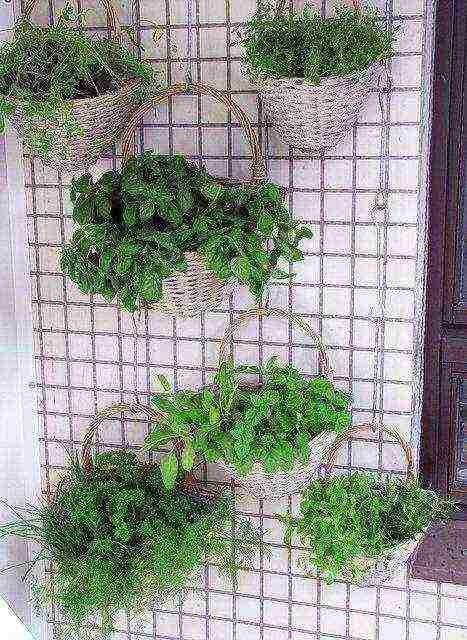 Multi-tiered solution on the balcony
Multi-tiered solution on the balcony
Care Tips
If you want to grow herbs, transplant or plant in large pots immediately after purchase. Because often the pots in which they are sold in garden centers or supermarkets are too small. Young grass roots lack room for full growth.
Spicy herbs are used often, as a rule, they do not require a lot of water. So in order to avoid waterlogging of the roots, it is better to use small shards or expanded clay at the bottom of the pots as drainage. Expanded clay absorbs excess water and returns it gradually when the ground is dry. Also, too much heat can damage plants and dry out the soil quickly. It is better not to put pots close to heat sources.
If you don't have time to use or want to dry out excess herbs, cut no more than half so that the other half will continue to grow. In this case, you will always have fresh herbs.
Do you have a balcony? It is great for growing herbs in the summer.
Do you only add salt and pepper as spices to your dishes? Then you should definitely try fresh herbs. Spicy herbs make it possible to quickly and easily raise pep. They give the dish a herbal spicy and interesting taste and aroma.
Fresh herbs are essential spices in everyday life: parsley, green onions, dill and other herbs can be quickly picked up in the right amount at any time, chopped into the right dish. Fresh herbs on the windowsill or in the garden are always at hand and can be harvested according to personal preference. How to use fresh herbs skillfully and what are the alternatives, make your own conclusion.
Herbs: what's with what?
Those who use spices in their dishes made from fresh herbs consume less salt. And salt, as we know, retains water in the body. Because of their high mineral and vitamin content, herbal blends make an important contribution to a healthy diet. Valuable ingredients are retained in most fresh herbs. Before use, it is enough to rinse them under running water without heat treatment.
Herbs commonly used in cooking
- Basil goes well with almost all Mediterranean dishes. It acts on appetite, has a detoxifying effect. Fresh leaves can be chewed for fresh breath. Basil comes with green, purple and purple leaves. It belongs to the mint family of plants, gives dishes a piquant spicy taste and aroma. Used in salads and as a decoration, the velvety leaves look great. Excess basil can be easily frozen: chop the leaves, mix with a little olive oil, close the jar and freeze.
- Green onions are like a miracle of nature, thin stems come out almost like from a constructor. Their taste is a little pungent. They can be used raw in salads and sauces. If you want to get feathers saturated with vitamins, in no case grow onions in water, plant them in the ground!
- Wild garlic is better than regular garlic, it doesn't smell. The dish tastes better with wild garlic. It contains iron, accumulates in the blood, lowers blood pressure and strengthens the heart.
- Savory strengthens the stomach, aids digestion and invigorates. Savory is often used in legume dishes. It fights the side effect of legumes with gas. Savory helps the digestion of starchy foods and game. Whole branches are added to the pot when cooking and achieve a good flavor.
Important! Don't confuse savory with thyme!
- Borago, in another way cucumber herb, resembles the taste of cucumber with an onion flavor. It is considered as a diaphoretic, diuretic, cardiotonic agent. Contains a lot of potassium, ascorbic, organic acids, carotene. It is a substitute for cucumber, it is added to various salads, sauces, hot dishes, cold vegetable soups. Borago gives a spicy taste to fish, minced meat, minced meat. It is also used as a perfume for various drinks.
- Burnet has a soft, cucumber-like aroma, ideal for herbal sauces and salads. Borage herbs have a similar taste. Applies to fish, drinks and sauces. Young leaves of burnet are used for canning. The leaves are used in cooking in soups, salads, egg and fish dishes, cocktails, and drinks. The roots are boiled and used as a side dish. Leaves and roots are brewed like tea.
- Watercress is very similar in taste to horseradish, to some it resembles a radish. Has a pungent flavor and can be applied to dairy products, eggs or chicken. It contains a lot of vitamin and strengthens the immune system. There are different types: curly, with narrow and with ordinary leaves of different ripening periods. It is eaten both raw and with meat dishes. Especially in the west, watercress is widespread. In our country, watercress is also becoming very popular lately.
- Rucolo tastes peppery-spicy and sour-fresh. Stimulates appetite and digestion. Great for salads, as well as risotto, pasta or fish.
- Dill stimulates appetite and relieves indigestion. It is ideal for cucumbers and fresh fish, especially salted sea fish.Dill has been used in cooking since ancient times and is the most common herb in the kitchen. Harvest time is early summer. It can be both dried and frozen. Stored in the freezer throughout the year. The seeds are used in Indian and South American cooking. When salting, we cannot do without this plant. Dill is said to calm the nervous system.
- Parsley is suitable for almost all dishes. It is rich in provitamin, vitamin B, B2 and calcium. Parsley stimulates the kidneys, purifies the blood and aids digestion. Parsley is common and curly. It is compatible with all other spices and goes well with almost any dish. It is also often used to decorate a dish, bringing a fresh look and rich flavor to stews, meats and many other foods. Regular parsley has a richer flavor than curly parsley.
- Oregon is used in many sauces. It is hard to imagine Italian pizza and herbal blends without it. You can also use a sprig of oregon with cheese. Even when dried, the aroma remains if stored in a sealed jar. The spicy, slightly pungent Oregon flavor works well in salads. Oregano (second name) has a tart, slightly peppery taste and is used a lot in Italian and Greek cuisine. Promotes appetite and soothes the nerves.
- Rosemary smells great! The branches are narrow, needle-like, reminiscent of a green forest. Rosemary is a versatile herb that goes well with poultry and pork, whether roasted or roasted. Contains many essential oils that stimulate appetite. It in a pot gives the feeling of a vegetable garden in a Mediterranean garden. Rosemary relieves headaches, calms the nervous system, has a positive effect on the gastrointestinal tract and biliary activity.
- Thyme goes best with meat and potato dishes. Oddly enough, thyme, unlike many other herbs, is stronger than that of fresh. Thyme has a spicy - sweet taste and its wonderful aroma only develops when food is cooked. It has a calming, antispasmodic, expectorant effect.
- Tarragon has a high content of essential oils that have a spicy bitter taste. It stimulates appetite and gastric acid secretion. It is used for main dishes of pork, lamb, beef.
- Wormwood is an ideal herb for rich and satisfying dishes, adding piquancy. It stimulates bile flow and thus guarantees optimal digestion of fats. Only the young upper leaves of wormwood are consumed before flowering. Often used for the production of liqueurs. There are countries where bread is baked with the addition of wormwood and juniper berries.
- Chervil stimulates metabolism, purifies blood and removes toxins. Has a slightly spicy taste with parsley and vanilla aromas, fresh leaves and stems are used for a slightly sweet aroma. It is good for diet soups, eggs, and poultry dishes. Perfectly harmonizes with crabs and even Frankfurt Green Sauce. In Sweden, brandy is produced with fresh chervil and vodka. Chervil is used only in green form. It should be added to the dish just before serving. Chervil greens are a good source of ascorbic acid, protein, vitamin C, glycosides, mineral salts, provitamin A. It lowers blood pressure, improves digestion.
- Coriander is a typical herb in Asian cuisine and has a light anise flavor. It is suitable for cream dishes, promotes appetite and relieves bloating.
- Lovage is used mainly for making soups and stews, for pastries and drinks. Even a small amount can add a special mushroom flavor to canned food. It is diuretic and therefore good for the kidneys and bladder. Often used in dietary nutrition.
- Marjoram goes well with meatballs or fried potatoes. It has a particularly calming and relaxing effect on the gastric mucosa.Marjoram is used in almost all German sausages because of its powerful, spicy flavor. And the potatoes are perfect with marjoram. It comes from Mediterranean cuisine and can be used for all hearty dishes.
- Mint goes well as a standard decoration for desserts and mixed drinks, as well as for meat, fish and yogurt sauce. Peppermint essential oils stimulate the secretion of bile and soothe the stomach and intestines. The taste of green leaves refreshes the taste of salads, young potatoes. There are different types of mint, the most famous being peppermint.
Tip: To quench your thirst, brew fresh mint, delicious!
- Dried Laurel is found in every kitchen. Stewing, preparing sauerkraut is hardly possible without an intense taste. An evergreen laurel shrub can be grown as a houseplant.
- Nettle is used raw, but scalded briefly to avoid biting. It tastes like spinach. Nettle is rich in vitamins, minerals, and is helpful in building blood support. Cabbage soup is made from young nettle. Try nettle dumplings.
- Balsam (Sarmatian censer), young leaves give yoghurt and other dairy products a fresh aroma. Its taste is reminiscent of lemon, although the leaves are similar to nettle. Melissole censer is added to various drinks and balms.
Also, mint and thyme can be added to tea for flavor and as a decoration to various drinks. Spicy herbs not only look beautiful but also taste great in food. As you can see, many herbs have medicinal and health benefits. You decide what kind of grass to grow on the windowsill based on your own preferences. Remember that in nature, greens are caressed by the wind. Do not place the pots too tightly so as not to obstruct the movement of air.
For those who have read the article to the end, a recipe for a special oil.
Herbal oil at home
On store shelves, you could see herbal oils. They are not cheap. You can easily make herbal oil yourself. Simply add the desired aromatic herbs to the oil bottle and leave to mature in a dark place for 4-6 weeks. You can use all varieties of fresh or dried herbs and create an oil to taste. Fresh herbs contain more aroma than dried herbs, as essential oils are lost during drying.
 Oils with various herbs
Oils with various herbs
Similar articles:
 Many housewives have large windowsills and think about how to grow greens at home. In fact, there is nothing complicated, many types of green plants do not require special care, feeding and additional lighting. Greens can be grown all year round. It is tasty and healthy, especially during the period of vitamin deficiency. Indispensable food additives can be grown.
Many housewives have large windowsills and think about how to grow greens at home. In fact, there is nothing complicated, many types of green plants do not require special care, feeding and additional lighting. Greens can be grown all year round. It is tasty and healthy, especially during the period of vitamin deficiency. Indispensable food additives can be grown.
Juicy spicy herbs are indispensable for activating metabolic processes in the body, has an expectorant, disinfectant, diuretic effect.But first things first.
Soil preparation and containers
It is better to grow greens in plastic containers, wooden boxes are not practical, heavy and often leak. Several varieties of herbs can be planted in one long container at once, but taking into account their combination with each other, irrigation conditions. For example, dill, parsley and celery will get along in one container, but marjoram, thyme and oregano need their own space.
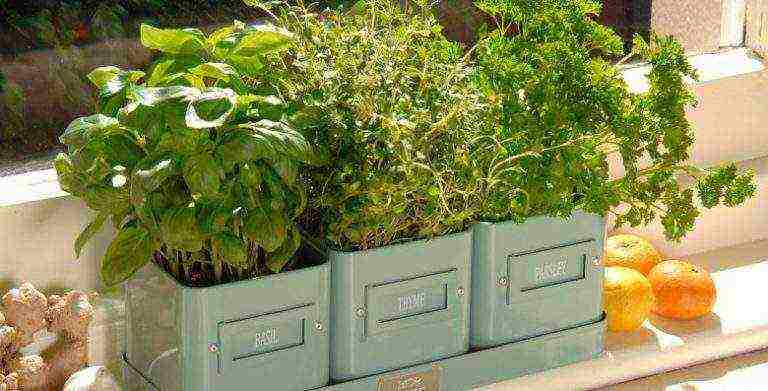
The most optimal composition of the earth (soil) is peat, earth, river sand and sawdust, taken in equal proportions. For drainage, it is advisable to put pebbles or expanded clay on the bottom of each vessel with a layer of up to 5 cm. To create the required moisture level, you need a piece of plastic wrap or plastic bottle caps. They need to cover the sown seeds for faster germination.
All types of greens, how to grow
Growing greens at home for some types of greens has its own characteristics. The easiest way to get a harvest of onions for a feather, dill and parsley.
To obtain large and juicy rucolla leaves, the containers should be kept with sufficient light and humidity. The topsoil should be kept moist at all times. Rucolla loves moisture, also feeding, adding nitrates. Seeds are sown to a soil depth of 11-12 cm, top up with a small layer of earth - up to 1.5 cm. In a week, you can expect the first shoots to appear. When leaves reach a height of 7 cm, they can be cut and added to salads.
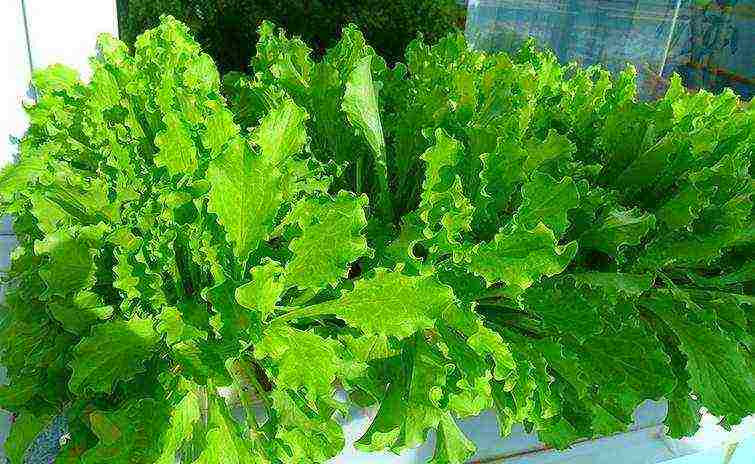
Celery prefers to grow in fertile, nutritious and moist soil in moderation. Planting seeds are disinfected with a solution of potassium permanganate, soaked for a day in warm water, wrapped in a damp cloth and left for some time in a dark place. It is important not to let the fabric dry out and spray it from time to time.
The hatched seeds are ready for planting. Place the seeds on the soil layer at a distance of up to 6 cm from each other, sprinkle with a small layer of earth, put on a warm, lighted place. The optimum temperature regime for celery is 25 g. Sufficiently overgrown plants will need to be thinned out, loosened up the soil. The best varieties for home cultivation: delicacy, snow globe, apple, mushroom.
Green juicy spinach leaves are rich in provitamin A, vitamins PP, B, C, vitamin B2, mineral salts, easily assimilated iron, iodine in large quantities. With anemia, such a vitamin and mineral composition of spinach is simply irreplaceable. With its regular use, hemoglobin will increase, vision and pancreas will improve, blood vessels will be strengthened. But children and people with high acidity need to take spinach very carefully. It contains a lot of oxalic acid.
Greens at home, such as spinach, require good watering and long-term lighting. First, the seeds are soaked for 2-3 hours in warm water, then they are planted in containers to a depth of 1.5 cm. The optimum room temperature is -18-21 g. After a couple of weeks, the crops need to be fed with mineral fertilizers to form wide and lush bushes. After 1-1.5 months, fresh herbs are ready to eat. The varieties are livable on windowsills: Virofle, Mazurka, fat-leaved Victoria, Melody.
Borago and marjoram
Borago is a cucumber herb, not as popular as other spices, although it is grown easily, in frequent watering and is not pretentious to bright lighting. Contains vitamin C, carotene, smells like fresh cucumbers. Borago is sown with seeds to a planting depth of 1.5-2 cm in sufficiently fertile soil. Containers should not be placed in drafts. The place should be warm, and the soil should be of high quality.
When such conditions are created, in 2 weeks it will be possible to admire the first shoots, and after 1.5 months, cut off the first juicy leaves for salads, which, by the way, can replace cucumbers if they are not on your table in winter.
Do not cut or discard the arrows that appear on the purple-flowered grass. They have a pleasant smell and taste of honey, they can be dried, added to baked goods, desserts and even to liqueurs, home-made liqueurs.

Marjoram is an unfamiliar spice for many, it is sold in bags as a dried seasoning for adding to meat dishes, soups, snacks, salads, pates. It is quite possible to grow it at home, in flower pots. Marjoram is a part of traditional medicine recipes for the treatment of kidneys, liver, respiratory organs, helps with headaches, toothaches, and is a good sedative.
Marjoram is an unpretentious plant; it is quite easy to grow it at home.
- Drainage is laid at the bottom of the container, on top - a layer of earth up to 15 cm, then - seeds with a depth of up to 2 cm, lightly sprinkle with earth on top.
- After that, the soil can be watered, placed on window sills with moderate lighting, but drafts should not be allowed.
- The first shoots will appear in a couple of weeks.
- After another 15-20 days - the first harvest.
Plants require regular watering.
Lettuce and mustard
Lettuce is rich in vitamins K, PP, E, B, potassium, iron, iodine. Low-calorie salad, used in many diet menus to normalize blood pressure, prevent sclerosis.
Drainage is poured at the bottom of the boxes, on top - a layer of earth up to 13 cm in height, then - a small layer of the nutrient mixture. You can sow the salad tightly, watering well, covering with a film and putting it in a warm place. When germinating seeds, move the boxes to lighter windowsills. The first seedlings after the appearance of 1-2 leaves should be dived, planted. For the rapid growth of lettuce, the soil should be fertilized, fertilized in the complex. Watering 3-4 times a week for juiciness and freshness of the leaves. In about a month, the first crop will be ready for harvest.
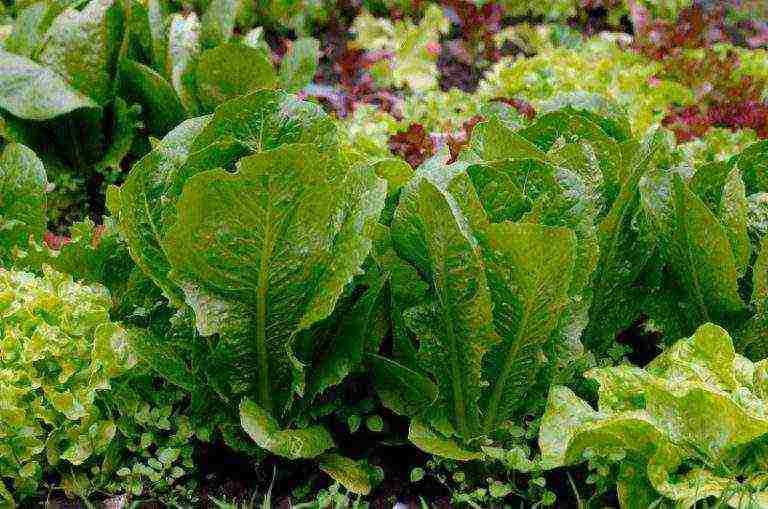
Watercress containing carotene, sulfur, potassium salts, vitamin C. When salad is added to the diet, blood pressure and sleep are normalized. The salad is not picky about growing conditions. Grows in the shade, on windowsills facing north. Soil up to 12 cm is poured into the container, seeds are planted with a depth of 1 cm, slightly covered with the top layer of earth.
For the appearance of quick entrances, you need to water abundantly. After 2-3 weeks, the succulent leaves will be ready to eat. Lettuce grows well when applying fertilizers from mineral fertilizers, in sufficiently moist soil, the drying of which is unacceptable. Overheating of the air or insufficient watering will lead to coarsening of leaves, elongation of stems, and the formation of inflorescences. This salad is no longer good for food. The peppery, curly, ordinary, broad-leaved variety winters well on the windowsill.
Mustard greens grow well next to watercress. The seeds must first be soaked, after swelling, put on the prepared soil in boxes, sprinkle on top with a layer of up to 1.5 cm of earth, cover with foil to accelerate germination. Keep in a dark place until they appear. As soon as the first shoots appear, you need to remove the film from the plants and expose them to the light. The first harvest is in 15-25 days.
Mustard does not need to be kept at a high temperature or too much light. The best place is cool, shaded, and watering is moderate.
Green onions: growing in boxes (video)
Parsley, dill, basil and onions
Parsley with dill must first be soaked for a day to release essential oils, then deepen into the ground to 1 cm, keep the containers in a dark place until the first shoots hatch, watering the plants should be daily. Thickened seedlings should be thinned out. Feed min. fertilizers can be used after the first harvest of parsley and dill.
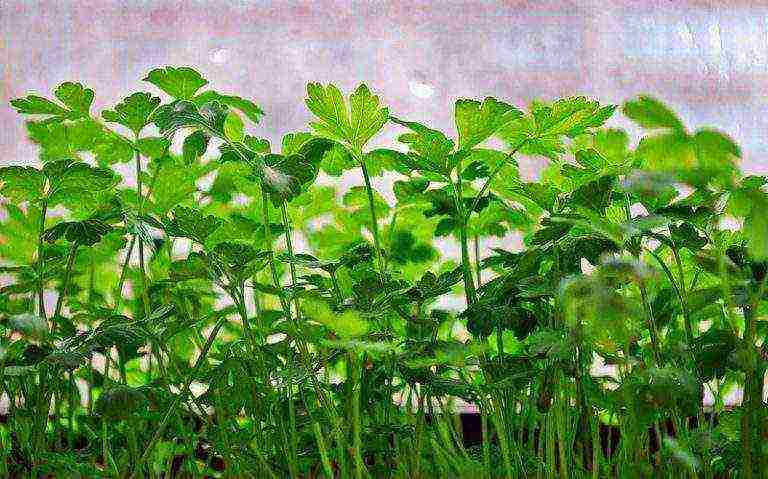
Mediterranean cuisine is not complete without aromatic basil. He loves light and warmth. In winter, it is worth taking care of additional lighting, as well as watering every day. You can plant seeds in flower pots. When the first shoots appear, apply complex fertilizers. To prolong the life of the plant, remove the peduncles during flowering.
What is easy to grow on a windowsill is an onion on a feather.
A can of settled water is enough for him. Scald the onion with boiling water, place it in a jar so that only the roots touch the water. When green arrows appear, cut periodically. New arrows will climb again until the bulb shrivels, but the water needs to be changed regularly.
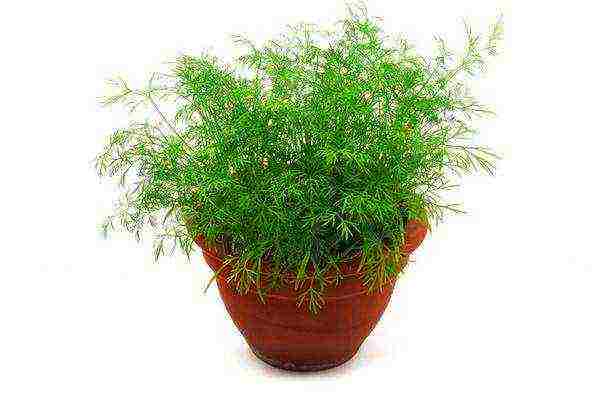
To grow green onions in containers, pour a layer of earth up to 7-8 cm, plant the bulbs, sprinkle with soil. Expose the boxes to light, preferably south-facing windows. With a lack of lighting, the flavoring and useful substances of the onion will be lost.
For forcing on a feather, it is better to plant small bulbs up to 2 cm in diameter. Plant in the ground at a distance of 2 cm from each other in half the volume of the bulb.
We grow greenery on the windowsill quickly and easily. Stock up on the right seeds in the fall. Delicious, fresh and aromatic spices will always come in handy in winter.
How to grow dill at home in winter (video)
Gallery: greens at home (15 photos)
At home on the windowsill, you can grow a whole garden of useful herbs, even if you live in an ordinary city apartment. Here are 10 of the best herbs to grow at home.
The herbs discussed below will provide health benefits and add a unique flavor and aroma to your meals.
And remember, plants lose half of their nutritional value within thirty minutes of being harvested, so growing your own herbs at home is a great way to get the most out of them.
Rosemary
This beautifully fragrant herb contains compounds that have been shown to fight cancer cells. In addition, the smell of rosemary, according to scientists at the University of Northumbria in the UK, helps to improve memory. Rosemary grows best in bright sunlight and frequent watering.
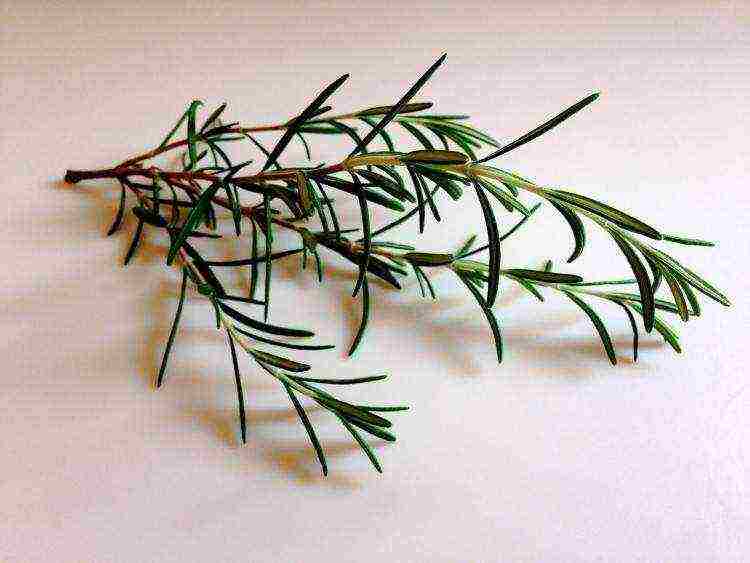
Thyme
Thyme has long been used as an herbal medicine, in particular for the treatment of bronchitis, as it has strong antiseptic properties due to the thymol it contains. Thyme contains practically no calories, but gives dishes a unique flavor.
And thyme flowers make this plant an attractive home decoration. Thyme grows well in abundant sunshine, but it can thrive quite well with incomplete sunshine.

Lavender
Its aroma soothes and helps to fall asleep. Lavender contains antioxidants polyphenols that help fight bloating.
This plant thrives best outdoors, in the sun (at least 8 hours of sunshine per day). If you choose to grow lavender indoors, make sure there are holes in the bottom of the growing container for water to escape.
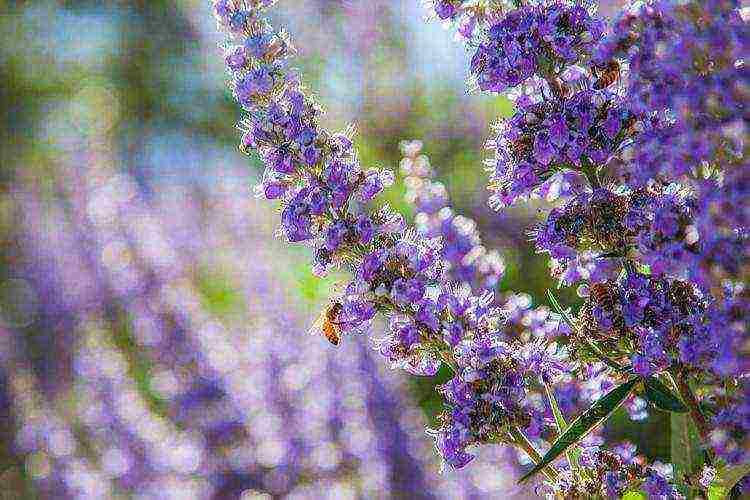
Basil
Basil is a great remedy for calming the nerves. It is a good source of fiber and helps cleanse the liver. It has a beneficial effect on the condition of the skin due to its powerful anti-inflammatory properties.
Basil grows easily, both indoors and outdoors. It does not require special care, you can water the basil every other day.
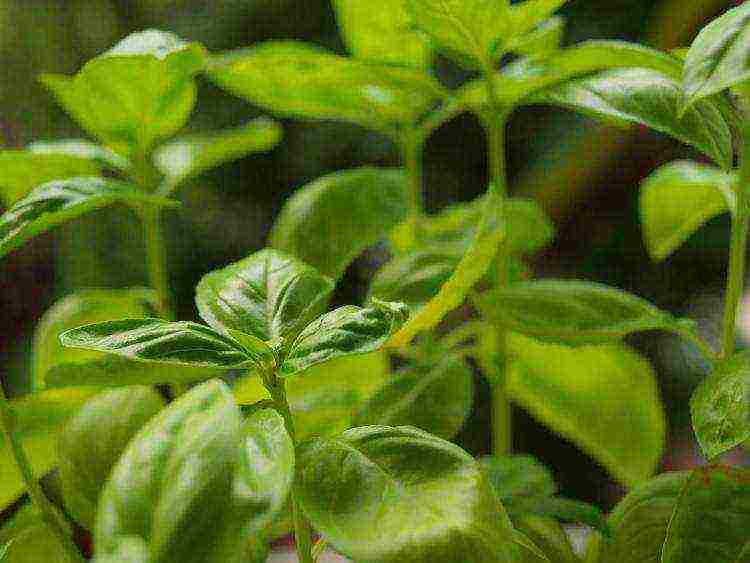
Parsley
Parsley contains vitamins A and C, only one tablespoon of this herb contains more than half of the recommended daily intake of vitamin K, as well as nutrients important for blood health.
Parsley is easy to grow - it doesn't require a lot of sunlight or special care. Just make sure the soil isn't too dry. If you cannot provide a fairly comfortable environment for her, she will grow more slowly.
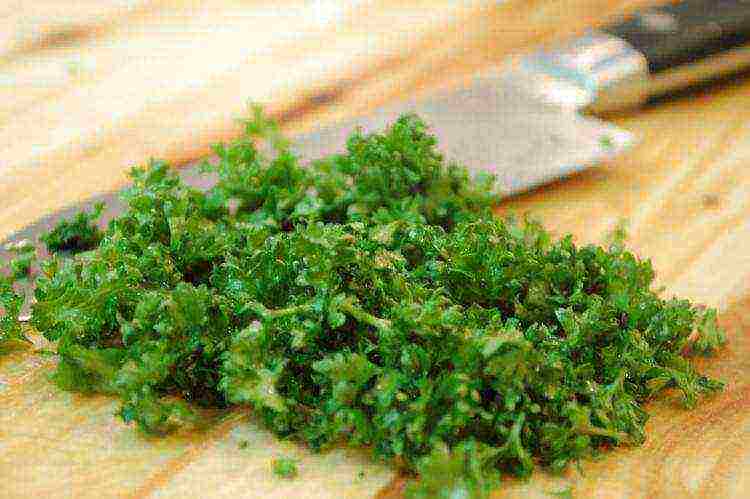
Sage
Sage is found in many cosmetics because it has antiseptic properties and contains antioxidants that can help fight aging.
In addition, sage is a natural remedy for anxiety and fatigue, and scientists say it is effective in preserving memory. Sage grows well in relatively high humidity. Just water it every day and give it enough light.

Coriander
A favorite herb in Mexican and Asian cuisines. A source of plant fibers and iron, promotes the removal of heavy metals from the body. Due to the long taproot, coriander needs a deep container with soil - then it will bloom well.
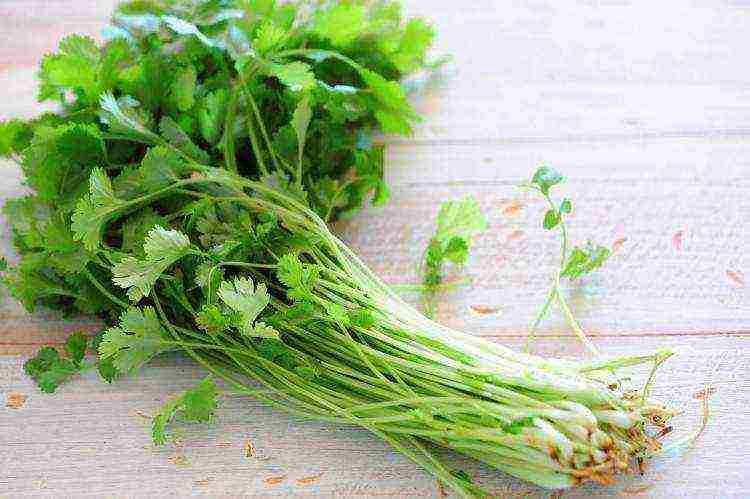
Chives
Helps to strengthen the immune system. According to research, regular consumption of chives is a good prevention of certain types of cancer, including cancer of the prostate, stomach and breast.
It grows very quickly. It can be grown indoors with little light. Chives grows up to 18 cm.
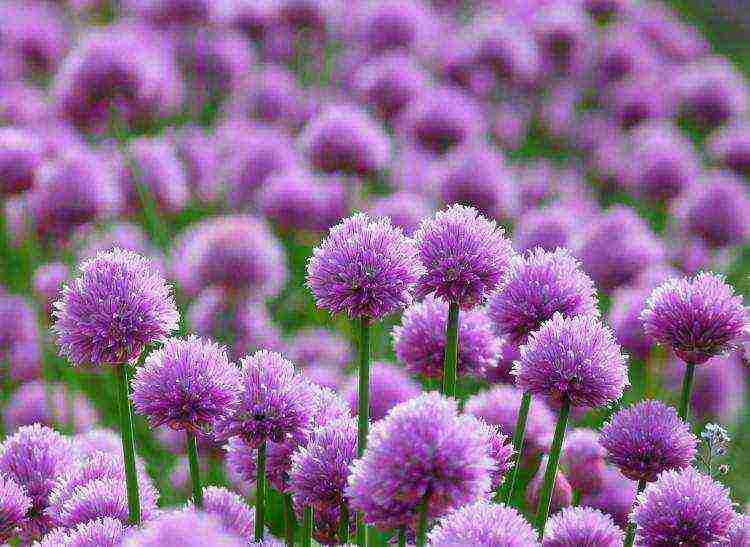
Dill
An excellent source of antioxidants. Some scientists call dill an excellent remedy for hiccups. The next time you hiccup, boil a teaspoon of chopped dill in boiling water, then strain the herb and drink it slowly. Should pass.
Dill requires a lot of sun and grows best in deep, loose soil, so it is best planted in a large pot.Watering dill is enough 1-3 times a week, according to the situation.

Mint
Mint is rich in vitamin A - two tablespoons of this plant contains more than half of the recommended daily intake of this substance. In addition, mint helps relieve nausea, headaches, respiratory distress, asthma, and acne.
Recent research has shown that peppermint essential oils have a positive effect on performance, blood pressure. It grows quickly and requires a lot of space. You can grow at home, but it is better to do it outdoors.
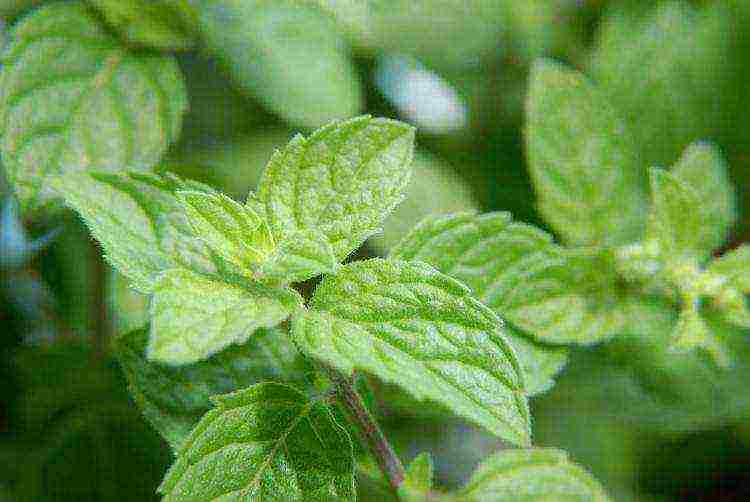
How to start growing your garden
Very simple. First of all, get the right size trays, seeds or plants directly, and buy organic growing mixtures if necessary.


